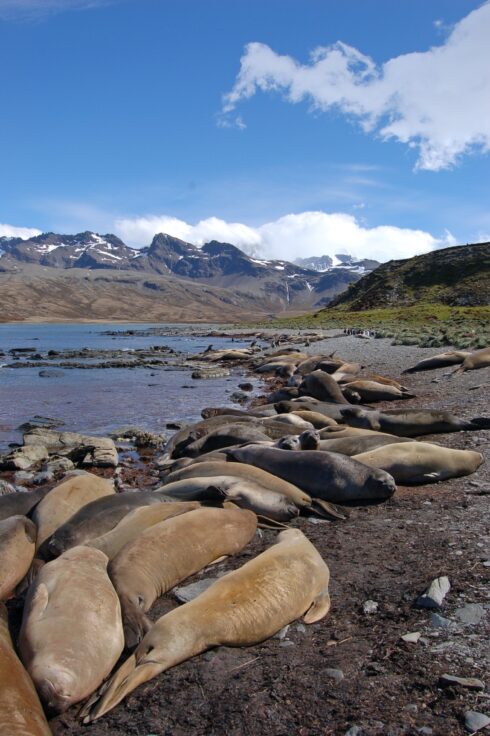A team of researchers are using drones and satellite images from space to count southern elephant seals on the sub-Antarctic Island of South Georgia. Using remotely piloted aerial systems (RPAS) to capture detailed 'on the ground' photos, the team will compare these with satellite imagery taken from space. This work will update the last island-wide census, conducted nearly 30-years ago.
This fieldwork, part of the Southwest Atlantic Elephant Seal Population Assessment (SAESPA) project, will calibrate census methods, aiming to improve the accuracy of population surveys for future conservation and monitoring of southern elephant seals.
South Georgia is a key biodiversity hotspot in the South Atlantic Ocean. The island is home to iconic and ecologically important species, including wandering albatross, southern elephant seals, king penguins, and humpback and blue whales that have recently recolonised the surrounding waters post-whaling.
Population data for southern elephant seals across the Southwest Atlantic is limited, and at South Georgia needs updating, despite the island being home to the world's largest breeding population of the animals. As climate change becomes an increasing threat to wildlife and habitats, safeguarding the future of elephant seals depends on gaining a better understanding about them.
The southern elephant seal (Mirounga leonina) is the larger of the two species of elephant seal, and is the largest member of the clade Pinnipedia, a group of carnivorous marine mammals that includes seals, sea lions and walrus. Southern elephant seals are the largest living marine mammal that is not a cetacean (the group that contains whales, dolphins, and porpoises).

To study these massive seals, the team, who are funded through the Biodiversity Challenge Fund Darwin Plus (DPLUS214), is spending several weeks at St Andrews Bay flying a lightweight surveying drone called the eBee X. With a wingspan of about 1.2 meters (4 feet), the eBee X looks similar to a sleek, compact glider. Its lightweight frame and distinctive fixed-wing design allow it to soar over the rugged coastline and open beaches, capturing high-resolution images of breeding colonies from above.
British Antarctic Survey researchers are working to fill the knowledge gap by carrying out a comprehensive census of breeding populations of southern elephant seals using satellite imagery. They will count breeding numbers on South Georgia, South Orkney and the South Shetland Islands, with this year's field season being primarily based at St Andrews Bay, South Georgia. The team is aiming to gain a better understanding of how well the species is faring across the South Atlantic.
Jaimie Cleeland who is the science manager for BAS's King Edward Point Research Station on South Georgia says:
"Understanding the size of the southern elephant seal population on and around South Georgia-and how it's being impacted by regional environmental changes-is essential. By pinpointing the peak of the breeding season and conducting our counts at that time, we can get an accurate picture of what's happening. Southern elephant seals play a crucial role in the Southern Ocean food web, and this project advances our ability to monitor and protect them well into the future."
Connor Bamford, who leads this project says:
"Southern elephant seals are a major component in the South Georgia, and wider Southern Ocean ecosystem. However, our understanding on how the population at South Georgia is fairing is limited as the last census was conducted in the mid-1990s. This project aims to update our understanding and check in on this population – seeing how a series of extraneous factors have impacted these wonderfully charismatic animals over recent years."






